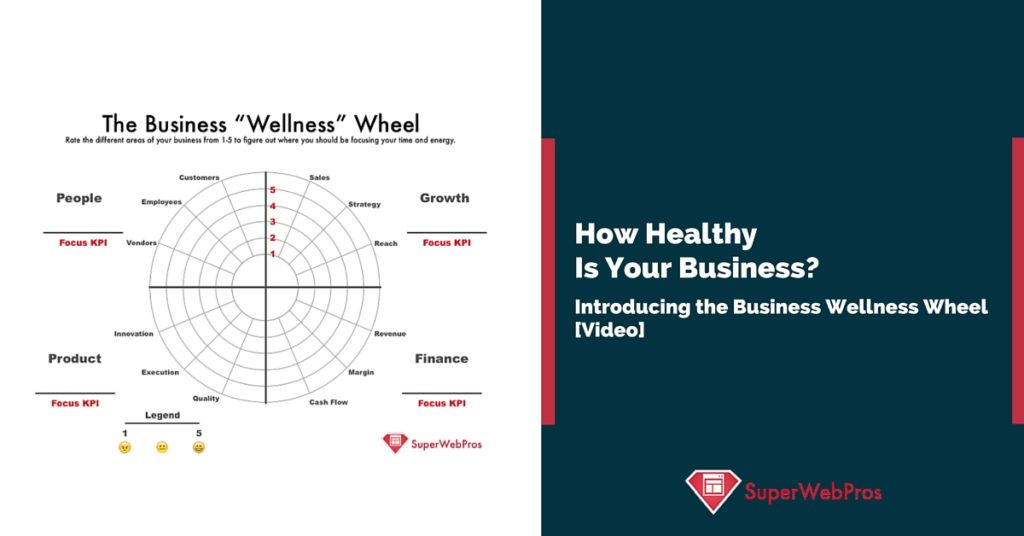If you’re like most businesses, there’s a good chance that there are multiple areas competing for time, attention, and resources.
At least, that’s been the case for us.
So, today, I wanted to share a tool that we created to help make it a little easier for us to figure out where to focusboth in the present and in the future.
The Tool
When a business is running smoothly, it’s because, at it’s core, multiple dimensions of it are functioning well.
It’s like a well-inflated wheel – round and optimized for performance.
That thought led us to come up with this:
 Here’s how it works:
Here’s how it works:
- Given each of the four dimensions of your business,
- Evaluate how you’re performing from “1” to “5”, with “1” being really poor and “5” being “awesome”
- Connect the dots between the elements
- Use the result to quickly identify ‘unhealthy’ areas of your business (as well as your ‘strengths’)
- Then, identify a core metric to focus on, so you can improve the business
- Repeat quarterly and annually
You can keep a record of your ‘wheel’ and see how it changes over time.
The Four Dimensions
There are many different models that experts, MBAs, and strategists use for reflecting areas of a business.
When we thought about our situation, we identified 4 major categories and 12 subcategories that reflected our ‘wheel.’
Dimension 1: Growth
Growth is one of the most important facets of any healthy business. Maybe the most important facet. I think of growth as a function of three things:
- Sales
- Strategy
- Reach
Subdimension: Sales
I believe it was Mark Cuban who said “Sales solves all problems.” It’s true. The more sales we have, the more we’re bringing in, the more cash we’re bringing in, the easier it is to fill all the other roles necessary to get more sales. And so on.
This is an obvious facet of growth.
Subdimension: Strategy
It may seem ‘obvious’ that ‘marketing’ would be the next subdimension, but ‘marketing’ seems too broad to me. And really fluid – by marketing do we mean ‘advertising?’ Or by ‘promotion’ do we mean social media? Search engines? Experiences?
You get the idea.
All of those things are intended to provide greater ‘reach’, but must be aligned as part of a broader strategy. And, they must be aligned with sales.
So, from the perspective of “Growth”, having a coherant, consistent strategy seemed an appropriate dimension for making sure the ‘wheel’ stayed round. Without a strategy, what we post, where we advertise, and how we communiate doesn’t matter.
With a strategy, it becomes much clearer to figure out how to do those things. And make sure they align with sales.
Subdomain: Reach
I tend to think of marketing’s job primarily being ‘delivering value, through a channel, to a group that cares about that value.’
It’s a broad concept, and that breadth is part of what makes marketing so challenging. And it underscores why we need a strategy.
The strategy informs the “what value” and the “who cares.”
Reach is a measure of how well the various channels we’re employing facilitate the strategy. If my strategy calls for Facebook advertising, how good is my reach? How efficiently am I delivering value through that channel to an audience that cares?
Because each channel has it’s own way of measuring things (metrics for Adwords & Facebook Ads & Twitter are all different, because the channels are used for different things), “Reach” becomes an ‘encompassing’ metric for the overall health of our respective efforts, by channel.
You seem to be enjoying this article. If you want a FREE Copy of the Business Wellness Wheel to use for your own business, you can download it here!
Domain 2: Finance
Ok, so I lied earlier.
Sales doesn’t solve all problems.
The cash from sales does.
Cash is the fuel of a business and a strong indicator of a business’ health.
So, within the context of finance, there are three subdomains:
- Revenue
- Margin
- Cash Flow
Subdomain: Revenue
This is how much money we make. It’s really important.
Obviously.
No revenue -> No business.
Subdomain: Margin
There are a few different ways to think about margin from a “business school” perspective. There’s “gross” margin, which is the difference between how much we can sell our product or service for and what it costs to produce that product or service…purely in terms of raw material and delivery.
There’s “operating” margin, which is the difference between how much we can sell our product or service for and what it costs to produce plus the overhead involved in producing it.
And I’m sure there are others that I’m not thinking of.
Every business will be different, but when we constructed this model, we were thinking of gross margin. Because the difference between what it costs to serve our customers and what we can sell our service for, the more comfortably we can make choices about where or how to allocate resources further down the value chain.
In other words, we can choose to add additional overhead or not. We can invest in this effort or not.
But we can’t not serve our customers.
And that money needs to cover anything else we choose to invest in.
As a rule, higher margins are always better…which is why it’s always struck me as odd that so many young companies want so much to compete on price.
As an aside, if you are going to compete on price – which, at some level, we do, then you need to pay attention to operating margins because you have less “gross” available for allocation. You must be thrify. Aside, over
Subdomain: Cash Flow
Cash is king.
Yet, many of us don’t watch cash as much as we should.
We extend credit to our customers, we don’t generate invoices quickly…or collect on them quickly, or focus enough on sales…you get the idea.
Cash flow is simply a function of the difference between the cash coming in and the cash going out. Ideally, we have cash coming in at a faster rate than the cash goes out. Which is what fuels the business.
I’ve not always watched cash as closely as I should. And I’ve been bitten. Every. Single. Time.
You sure you don’t want a FREE Copy of the Business Wellness Wheel to use for your own business? You’ve already made it this far! And, you can download it right here!
Domain 3: Product (Or Service)
This is the thing that most of us entrepreneurs love – the product or service that we sell. For many of us, it’s why we got into business in the first place.
So, it deserves some focus. Because, if we have nothing to sell, then we have no business (starting to see how interconnected all these things are?). And, if those things aren’t good, then we’ll be out of business before long.
Similarly, if we aren’t getting better, the business will stagnate.
So, the subdomains within “Product” are:
- Quality
- Execution
- Innovation
Subdomain: Quality
Do we do good work? Does our product or service deliver on the value we promised?
Pretty straightforward.
Subdomain: Execution
This gets at the ‘operating margin’ topic I mentioned above.
Do we build, manufacture, assemble, and deliver the good or service we’ve committed to in an efficient way? Is our operation ‘lean’, meaning that we don’t invest in any unnecessary overhead and we generate positive returns on the investments we do make?
Do we even measure that?
We should.
Subdomain: Innovation
Innovation is ‘all the rage’ with startups, but I’m often surprised at how many small businesses don’t really seem to think in those terms.
Innovation doesn’t have to be a monumental new insight or invention that changes the world.
In many cases, it isn’t.
What it is, however, are finding new ways to serve our customers better.
It’s about consistently striving to create more value.
And baking that into the DNA of the company.
Healthy organisms are always growing, adapting, and evolving.
Healthy business should, too. And innovation is the way they do that.
You’re running out of ‘in-text’ opportunities to get your FREE Copy of the Business Wellness Wheel to use for your own business…Just takes a second and you can download it right here!
Domain 4: People
At some level, it’s all about people.
We need to do business with vendors in order to deliver our value. Vendors are people.
We require employees to manufacture, assembed, and deliver that value. Employees are people.
And we sell to customers, who value what we do. Customers are people.
Any healthy business recognizes that people are often it’s greatest asset. And those people are typically one of:
- Vendors
- Employees
- Customers
Subdomain: Vendors
It may seem strange to think of vendors as people with whom we have a relationship. But we do. And that relationship manifests itself (from our end) in a few ways:
- How many vendors we have
- How well we pay them
- Our payment terms
- The amount of business we do, per vendor
Vendors, reciprocally, relate to us in terms of:
- How well they serve our needs
- The payment terms they afford us
- Whether they meet their service commitments
Our vendors often hold the keys to our ability to execute, at some level. Our role is to make sure we treat good vendors well and diversify when vendors aren’t performing.
Subdomain: Employees
There’s a reason Jim Collins’ book “Good to Great” opens with “The right people on the right seat.”
Because how well our business performs is a function of the sum of people working on the business, it’s really important to have good people doing good work.
This can be hard when starting up and there is often a tradeoff between ‘hiring well’ and ‘saving cash.’ The wheel helps us quantify how well or poorly we’re making that tradeoff.
Subdomain: Customers
Customers are awesome. They keep us alive.
Most of the time.
Some customers aren’t so awesome. They require more than we’ve agreed to give and don’t appreciate everything that comes with that. So, sometimes, we must fire bad customers.
But, generally, customers are awesome. And we should consistently find ways to improve their experience…especially once they’re customers.
How well do we, for instance, demonstrate our appreciation or honor our customer relationships once we’ve won the business? Or, do we ‘set it and forget’, looking for the next business?
My own answer to that question has been shameful at times.
Where’s Your Focus?
After evaluating our performance across these dimensions, it often becomes clear that there is one or more areas that require attention.
That’s the purpose of the “Focus KPI” – to identify and explicitly call out the metric that requires the most attention. So, that every time we look at our wheel, we’re asking the question…”how am I doing on metric X?”
Pick 1
I’ve learned the hard way that focusing on multiple metrics when you’re small can be detrimental to growth. Diffused attention means that nothing really gets full attention (by definition). And so it can be hard to make progress.
This is especially true for the solopreneur.
For slightly larger companies, though, where there is a CEO, CFO, COO, and CHRO, then it might make sense to have each one of those people focused on a different performance metric (KPI) and be held responsible for that single metric.
The Wheel Is Not Perfect
This wheel is not perfect and doesn’t necessarily work for every business. But, it’s intended to be general enough that it should work for most. And, it’s easy enough to recreate with the dimensions that make sense for your business.
But, even if it’s not a perfect fit for your business, at least it’s a helpful way to visualize your performance and which areas ought to get attention quickly and easily.
Just Measure
Whether this wheel is right for you – or not – the important takeaway is to pay attention. And to measure performance. Across each of the dimensions of your business.
By paying attention, measuring, and executing well, your business will grow.




